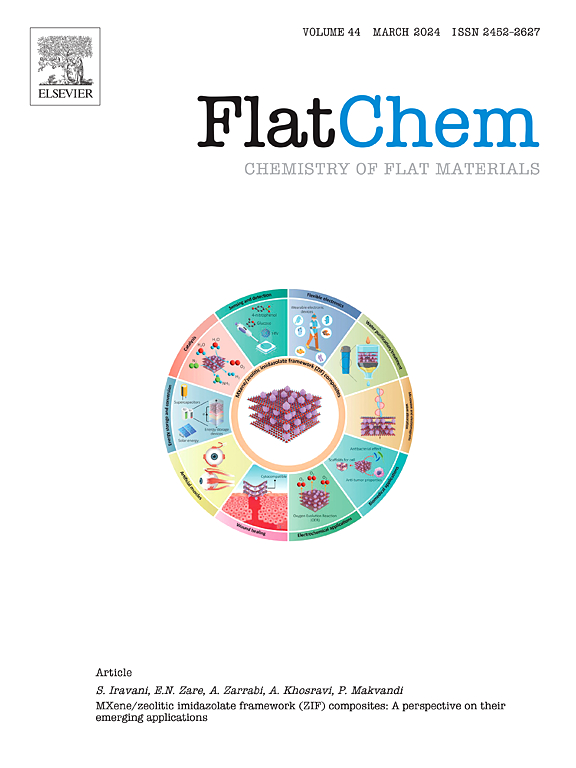利用氮掺杂氧化石墨烯导电油墨制备的柔性电化学传感器,通过辅助因子NADH再生非酶测定乳酸的新策略
IF 6.2
3区 材料科学
Q2 CHEMISTRY, PHYSICAL
引用次数: 0
摘要
本研究提出了一种非酶法检测乳酸盐的新方法,即利用 NAD+ 代替传统的酶或金属纳米粒子再生 NADH。电极由开发的导电油墨制成,乳酸盐浓度与 NADH 氧化峰值电流之间存在明显的相关性。在该系统中,乳酸盐不仅是一种分析物,还是一种质子源,在 NAD+ 的电化学还原过程中促进了 NADH 的再生。在导电墨水中加入掺氮氧化石墨烯作为第二个质子源,进一步改善了 NADH 的形成,提高了乳酸盐检测的整体效率。使用循环伏安法、电化学阻抗光谱法、场发射扫描电子显微镜、能量色散 X 射线光谱法、傅立叶变换红外光谱法和 X 射线光电子能谱法对电极进行了全面表征。电极对乳酸盐的检测限达到了 2.11 μM。重要的是,所开发的电极成功地检测了人工汗液样本中的乳酸盐,从而突出了其实用性。这项研究不仅推动了电化学生物传感领域的发展,还为监测生物和临床环境中的乳酸盐水平开辟了新途径,展示了无酶检测方法的潜力。本文章由计算机程序翻译,如有差异,请以英文原文为准。

New strategy for non-enzymatic determination of lactate via regeneration of cofactor NADH using flexible electrochemical sensors prepared with nitrogen-doped graphene oxide conductive ink
This study presents a novel approach for non-enzymatic lactate detection by regenerating NADH using NAD+ instead of traditional enzymes or metal nanoparticles. The electrodes were fabricated from the developed conductive inks, demonstrating a clear correlation between the lactate concentration and NADH oxidation peak current. In this system, lactate functions not only as an analyte but also as a proton source, enhancing the regeneration of NADH during the electrochemical reduction of NAD+. The incorporation of nitrogen-doped graphene oxide into the conductive ink as a second proton source further improved NADH formation, increasing the overall efficiency of lactate detection. The electrodes were thoroughly characterized using cyclic voltammetry, electrochemical impedance spectroscopy, field-emission scanning electron microscopy, energy dispersive X-ray spectrometry, Fourier transform infrared spectroscopy, and X-ray photoelectron spectroscopy. The electrodes achieved detection limit of 2.11 μM for lactate. Importantly, the developed electrodes successfully detected lactate in artificial sweat samples, thereby highlighting their practical applicability. This research not only advances the field of electrochemical biosensing, but also opens new avenues for monitoring lactate levels in biological and clinical settings, showcasing the potential of enzyme-free detection methods.
求助全文
通过发布文献求助,成功后即可免费获取论文全文。
去求助
来源期刊

FlatChem
Multiple-
CiteScore
8.40
自引率
6.50%
发文量
104
审稿时长
26 days
期刊介绍:
FlatChem - Chemistry of Flat Materials, a new voice in the community, publishes original and significant, cutting-edge research related to the chemistry of graphene and related 2D & layered materials. The overall aim of the journal is to combine the chemistry and applications of these materials, where the submission of communications, full papers, and concepts should contain chemistry in a materials context, which can be both experimental and/or theoretical. In addition to original research articles, FlatChem also offers reviews, minireviews, highlights and perspectives on the future of this research area with the scientific leaders in fields related to Flat Materials. Topics of interest include, but are not limited to, the following: -Design, synthesis, applications and investigation of graphene, graphene related materials and other 2D & layered materials (for example Silicene, Germanene, Phosphorene, MXenes, Boron nitride, Transition metal dichalcogenides) -Characterization of these materials using all forms of spectroscopy and microscopy techniques -Chemical modification or functionalization and dispersion of these materials, as well as interactions with other materials -Exploring the surface chemistry of these materials for applications in: Sensors or detectors in electrochemical/Lab on a Chip devices, Composite materials, Membranes, Environment technology, Catalysis for energy storage and conversion (for example fuel cells, supercapacitors, batteries, hydrogen storage), Biomedical technology (drug delivery, biosensing, bioimaging)
 求助内容:
求助内容: 应助结果提醒方式:
应助结果提醒方式:


